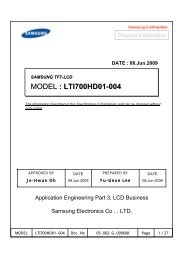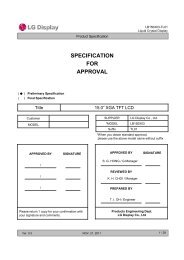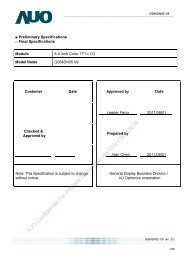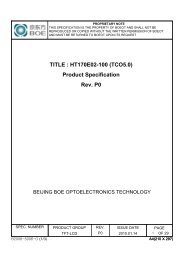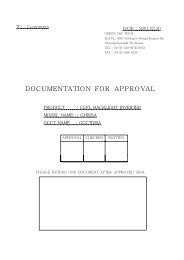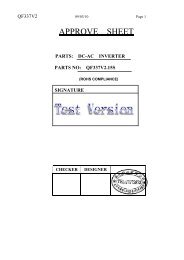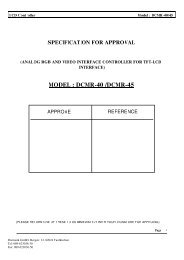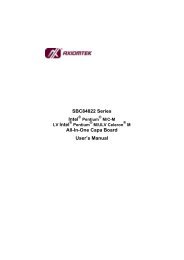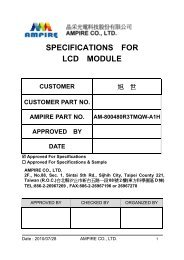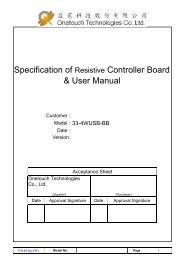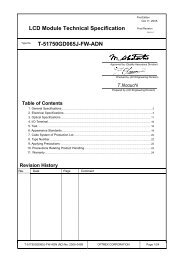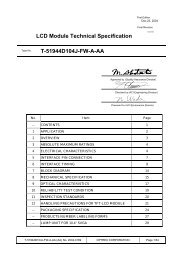You also want an ePaper? Increase the reach of your titles
YUMPU automatically turns print PDFs into web optimized ePapers that Google loves.
For <strong>LCD</strong>/PDP <strong>Monitor</strong> (PC, DVI, Video) Interface <strong>Control</strong>ler<br />
For 1280x768, 1366x768, 1600x1200, 1920x1080, 1920x1200 Resolutions <strong>TFT</strong> <strong>LCD</strong>/PDP<br />
DATA SHEET<br />
<strong>TFT</strong> <strong>LCD</strong> <strong>Monitor</strong> <strong>Control</strong> <strong>Board</strong><br />
DT-410U4-DS-A3<br />
OCTOBER 2005<br />
1
CONTENT<br />
• INTRODUCTION --------------------------------------------- 4<br />
• GENERAL SPECIFICATION --------------------------------------------- 5<br />
• SYSTEM DESIGN --------------------------------------------- 8<br />
• BLOCK DIAGRAM --------------------------------------------- 9<br />
• ASSEMBLY NOTES --------------------------------------------- 12<br />
• CONNECTION & OPERATION --------------------------------------------- 15<br />
• OSD --------------------------------------------- 16<br />
• OSD FUNCTION --------------------------------------------- 17<br />
• CONNECTOR, PINOUT & JUMPER --------------------------------------------- 28<br />
• CONTROLLER DIMENSIONS --------------------------------------------- 39<br />
• APPLICATION NOTES --------------------------------------------- 40<br />
• TROUBLESHOOTING --------------------------------------------- 41<br />
• APPLICABLE GRAPHIC MODE --------------------------------------------- 42<br />
• ACCESSORY --------------------------------------------- 43<br />
• APPENDIX --------------------------------------------- 44<br />
2
Revision History<br />
No Data Revision Page<br />
1 Preliminary Release<br />
A1<br />
.<br />
2 OSD update<br />
A2<br />
16<br />
Dimming jumper added<br />
A2<br />
35<br />
3<br />
Set ID & D-TV(HD) added<br />
A3<br />
11, 23<br />
3
INTRODUCTION<br />
Designed for <strong>LCD</strong> monitor and other flat panel display application the NCB410U4 controller<br />
provides an auto-input synchronization and easy to sue interface controller for:<br />
► <strong>TFT</strong> (active matrix) <strong>LCD</strong> panels of 1280x768, 1366x768, 1600x1200, 1920x1080 and<br />
1920x1200 resolutions.<br />
► PDP panels of 852x480, 1024x768 and 1366x768 resolutions.<br />
► Computer video signals of VGA, SVGA, XGA, WXGA, SXGA and UXGA standard.<br />
► Video signals of NTSC, PAL standard<br />
► Input Signal Support<br />
� All VESA standard<br />
HOW TO PROCEED<br />
► Ensure that you have all parts & they are correct, refer to:<br />
� Connection diagram<br />
� Connector reference<br />
� Assembly notes<br />
► Check controller switch & jumper settings (errors may damage the panel)<br />
► Prepare the PC & Video<br />
► Connect the parts<br />
► Understand the operation & functions<br />
IMPORTANT USAGE NOTE<br />
This equipment is for use by developers and integrators. The manufacturer accepts no liability for<br />
damage or injury caused by the use of this product. It is the responsibility of the developer,<br />
integrators or other users of this product to:<br />
� Ensure that all necessary and appropriate safety measures are taken.<br />
� Obtain suitable regulatory approvals as may be required.<br />
� Check power settings to all component parts before connection.<br />
DISCLAIMER<br />
There is no implied or expressed warranty regarding this material.<br />
4
GENERAL SPECIFICATION<br />
No. Item Description<br />
1 Model name<br />
WVGA Panel 8520X480 NCB410WV4 Note 1)<br />
XGA Panel 1024X768 NCB410X4<br />
WXGA Panel 1280X768 NCB410W4<br />
WXGA Panel 1366X768 NCB410WZ4<br />
UXGA Panel 1600X1200 NCB410U4<br />
HD Panel 1920X1080 NCB410WH4<br />
WUXGA Panel 1920X1200 NCB410WU4<br />
2 <strong>LCD</strong> Module SVGA, XGA, WXGA, SXGA<br />
3 Signal Input Analog RGB, TMDS(DVI). NTSC/PAL<br />
4<br />
5<br />
Resolution<br />
H: 31 ∼ 80kHz<br />
Support V: 55 ∼ 75Hz<br />
OSD <strong>Control</strong> Menu, Left, Right, Up, Down, Source, Power 8 keys<br />
Plug & Play VESA DDC 2B Ver1.3<br />
6 Power Connector Input<br />
7.<br />
Power<br />
Consumption<br />
8 Signal Connector<br />
Notes 1) Depends On Panel Resolution<br />
- WV : WVGA (850X480)<br />
- X : XGA (1024X768)<br />
- W : WXGA (1280X768)<br />
- WZ : WXGA (1366X768)<br />
- U : UXGA (1600x1200)<br />
- WH : HD 1080i (1920x1080)<br />
- WU : WUXGA (1920x1200)<br />
Type: IEC320 MALE 3Line<br />
Supply<br />
Voltage<br />
Connector<br />
12Vdc/15Vdc/18Vdc or 25Vdc<br />
Max Power 18W (Without Back Light Inverter)<br />
Analog<br />
DSUB 15P(R, G, B Separate H, V<br />
Sync)<br />
Digital DVI-D(TMDS) TMDS<br />
Video MINIDIN-4P(SVHS), RCA(CVBS)<br />
5
ELECTRICAL SPECIFICATION<br />
Input characteristic<br />
Description Signal Unit Min Typical Max Remarks<br />
Power In (24V)<br />
Power In (18V)<br />
Power In (15V)<br />
Power In (12V)<br />
RGB Input<br />
DVI Input<br />
NTSC/PAL<br />
Input Vdc 22.8 24.0 25.2<br />
Consumptio<br />
n<br />
Watt TBD Without INV<br />
Input Vdc 17.0 18.0 19.0<br />
Consumptio<br />
n<br />
Watt TBD Without INV<br />
Input Vdc 14.75 15.0 15.75<br />
Consumptio<br />
n<br />
Watt TBD Without INV<br />
Input Vdc 11.4 12.0 12.6<br />
Consumptio<br />
n<br />
Watt TBD Without INV<br />
Analog RGB Vp-p 0 0.7 -<br />
Sync Vdc 0 5 5.5<br />
H<br />
Frequency<br />
KHz 31 80 Depends on Mode<br />
V Frequency Hz 55 60 75<br />
TMDS mVp-p 450 500 900<br />
Y/CVBS Vp-p 0.7 1.0 1.4<br />
C Vp-p 0.6 0.8 1.0<br />
6
Output Characteristics<br />
Descriptio<br />
n<br />
Panel Power<br />
LVDS Interface<br />
Inverter Interface<br />
Signal Unit Min Typical Max Remarks<br />
<strong>LCD</strong> Power<br />
(18V)<br />
<strong>LCD</strong> Power<br />
(15V)<br />
<strong>LCD</strong> Power<br />
(12V)<br />
<strong>LCD</strong><br />
Power(5V)<br />
<strong>LCD</strong><br />
Power(3.3V)<br />
Differential<br />
output<br />
Vdc 17.1 18 18.9<br />
Vdc 14.25 15 15.75<br />
Vdc 11.4 12 12.6<br />
7<br />
Jumper option<br />
(Representative<br />
12V)<br />
Vdc 4.75 5 5.25 Jumper option<br />
Vdc 3.13 3.3 3.46 Jumper option<br />
Vp-p<br />
(mV)<br />
Power out Vdc<br />
250 350 450 Different +/-<br />
22.8 24 25.2<br />
17.1 18 18.9<br />
14.25 15 15.75<br />
11.4 12 12.6<br />
Depends on<br />
Power<br />
Input and Spec.<br />
On/Off control V 0 3.3 L=off, H=on<br />
Brightness<br />
control<br />
V<br />
3.3 0 Option<br />
0 4V Option<br />
Step 0 100 OSD Value
SYSTEM DESIGN<br />
A typical <strong>LCD</strong> based display system utilizing this controller is likely to comprise the following.<br />
J703<br />
J101<br />
4. OSD <strong>Board</strong><br />
J701<br />
J702<br />
JP701 Jumper for Inverter Power 24V or 12V/15V/18V<br />
J714<br />
J704<br />
J724<br />
1. <strong>LCD</strong> PANEL<br />
9. DC Power Jack (24V)<br />
8. DC Power Jack (12V/15V/18V)<br />
5. OSD KEY CABLE<br />
J801 LVDS 1CH J802 <strong>LCD</strong> LVDS 2CH<br />
J713 Internal<br />
J721 J903 J901<br />
10. Composite Input<br />
JP802<br />
J801 : Jumper for <strong>LCD</strong><br />
J718<br />
Norma<br />
J715<br />
J727: Jumper for Input<br />
Power<br />
3. <strong>LCD</strong> controller <strong>Board</strong><br />
11. S-VIDEO Input<br />
8<br />
12. DVI-D Input<br />
J90<br />
J803<br />
13. ANALOG VGA<br />
Input<br />
6. INVERTER CABLE<br />
7. <strong>LCD</strong> INTERFACE CABLE<br />
To RS232 <strong>Board</strong><br />
SW101<br />
Jumper for Panel<br />
J718<br />
J90
A typical PDP based display system utilizing this controller is likely to comprise the following.<br />
2. SMPS<br />
3. POWER CABLE<br />
J703<br />
J101<br />
J702<br />
J713<br />
7. OSD KEY CABLE<br />
1. PDP PANEL<br />
JP80<br />
JP801<br />
J704 PDP Power <strong>Control</strong><br />
J718<br />
J715<br />
J727: Jumper for Input<br />
J701<br />
J714<br />
8. OSD <strong>Board</strong><br />
JP70<br />
4. POWER CONTROL CABLE<br />
J724<br />
J721<br />
9. Composite Input<br />
6. PDP controller board<br />
J903<br />
10. S-VIDEO Input<br />
J901<br />
9<br />
5. <strong>LCD</strong> INTERFACE CABLE<br />
J801 J802 J803 PDP L<br />
J90<br />
12. ANALOG<br />
11. DVI-D<br />
SW101<br />
Jumper for Panel Type.<br />
To RS232 <strong>Board</strong><br />
J90
BLOCK DIAGRAM<br />
DVI<br />
DTV<br />
RED<br />
GREEN<br />
BLUE<br />
SYNC<br />
(DSUB 15P)<br />
CVBS<br />
SVHS<br />
(RCA, M4P)<br />
POWER<br />
VIDEO<br />
DECODER<br />
E 2 PROM<br />
SCALER<br />
DC/DC<br />
Power <strong>Control</strong><br />
10<br />
MCU<br />
LVDS<br />
Inverter
D TV Input ( Set top � RGB input : 1080i Support )<br />
: RGB to RGB or Component to RGB<br />
* In case of HD(1080i) signal input, it does not support PIP & PBP..<br />
11
ASSEMBLY NOTES<br />
This controller is designed for monitors and custom display projects using <strong>TFT</strong> (active matrix) <strong>LCD</strong><br />
panels of 1280x768, 1366x768, 1600x1200, 1920x1080 and 1920x1200 resolutions, PDP panels<br />
of 852x480, 1024x768 and 1366x768 resolutions VGA, SVGA, XGA, WXGA, SXGA, WSXGA and<br />
UXGA signal input. The following provides some guidelines for installation and preparation of a<br />
finished display solution.<br />
Preparation: Before preceding it is important to familiarize yourself with the parts making up the<br />
system and the various connectors, mounting holes and general layout of the controller. As much<br />
as possible connectors have been labeled. Guides to connectors and mounting holes are shown in<br />
the following relevant sections.<br />
1. <strong>LCD</strong> Panel: This controller has LVDS interface logic on the <strong>Board</strong> for different kind of <strong>TFT</strong> <strong>LCD</strong><br />
panel. Due to the different signal timing and electrical characteristics from each <strong>LCD</strong> panel<br />
manufacturer, for selecting <strong>LCD</strong> interface type and resolution, put jumper marked SW101 on the<br />
right position following <strong>LCD</strong> panel specification. For selecting DC power level, put jumper marked<br />
J801, J802 on the right position. Supplied power level depends on <strong>LCD</strong> panel specification.<br />
PDP Panel: This controller has LVDS interface logic on the <strong>Board</strong> for different kind of PDP panel.<br />
Due to the different signal timing and electrical characteristics from each PDP panel manufacturer,<br />
for selecting PDP interface type and resolution, put jumper marked SW101 on the right position<br />
following PDP panel specification.<br />
2. <strong>Control</strong>ler: Handle the controller with care as static charge may damage electronic components,<br />
Make sure correct jumper and switches settings to match the target <strong>LCD</strong> and PDP panel<br />
3. <strong>LCD</strong> connector board: Different makers and models of <strong>LCD</strong> panel require different panel signal<br />
connectors and different pin assignments.<br />
PDP connector board: Different makers and models of PDP panel require different panel<br />
signal connectors and different pin assignments.<br />
4. LVDS signal cables: In order provide a clean signal it is recommended that LVDS signal cables<br />
should not longer than 40cm. If loose wire cabling is utilized these can be a made into a harness<br />
with cable ties. Care should be taken when you place the cables to avoid signal interface.<br />
Additionally it may necessary in some systems to add ferrite cores to the cables to minimize<br />
signal noise.<br />
5. Inverter: This will be required for the backlight of an <strong>LCD</strong>, some <strong>LCD</strong> panel have an inverter<br />
built in. As <strong>LCD</strong> panels may have 1 or more backlight tubes and the power requirements for<br />
different panel backlights may vary it is important to match the inverter in order to obtain<br />
optimum performance. See application notes for more information on connection<br />
12
6. Inverter cable: Different inverter models require different cables and different pin assignment.<br />
Make sure the correct cable pin out to match the inverter. Unsuitable cable pins out may<br />
damage the inverter.<br />
7. AV cable: Standard composite or S-video cables can be used. Reasonable quality cables<br />
should be used to avoid image quality degradation.<br />
8. OSD Button: See Operational Function section.<br />
9. 3 Color LED: This LED shows the state of controller.<br />
� Green – Normal state<br />
� Red - Off mode (Can’t find video signals)<br />
� Amber – DPMS mode<br />
10. Power switch: This switch is located on OSD button board.<br />
11. Power input: Proper power is required to supply power for the controller, the Inverter and the<br />
<strong>LCD</strong> panel<br />
12. VGA Input Cable: As this may affect regulatory emission test result, a suitably shielded cable<br />
should be utilized.<br />
EMI: Shielding will be required for passing certain regulatory emissions tests. Also the choice of<br />
video board and power supply can affect the test result.<br />
Consideration should be given to:<br />
� Electrical insulation.<br />
� Grounding.<br />
� EMI shielding.<br />
� Heat & ventilation<br />
Caution: Ensure that the adequate insulation is provided for all areas of the PCB with special<br />
attention to high voltage parts such as the inverter.<br />
13
13. Setup for operation<br />
Once the circuit has been connected, a setup procedure for optimal is requires a few minutes<br />
the following instructions are likely to form the basis of the finished product operation manual.<br />
PC Settings<br />
The PC needs to be set to an appropriate graphics mode that has the same resolution with the<br />
<strong>LCD</strong> panel to have clear screen image. And the vertical refresh rate should be set to one of<br />
56~75Hz, non – interlaced signal.<br />
Display System Settings<br />
The OSD (On Screen Display) provides certain functions to have clear image and others. This<br />
board supports 8 buttons OSD operation as a standard. The control functions defined on OSD<br />
operation are as below.<br />
Pc Graphics Output: A few guidelines:<br />
� Signal quality is very important, if there is noise or instability in the PC graphics output<br />
this may result in visible noise on the display<br />
� Refer to the graphic modes table in specification section for supported modes.<br />
� Non-interlaced & interlaced video input is acceptable.<br />
Important: please read the application notes section for more information.<br />
14
CONNECTION & OPERATION<br />
CAUTION: Never connect or disconnect parts of the display system when the system is powered<br />
CONNECTION<br />
up as this may cause serious damage.<br />
1. <strong>LCD</strong> panel & Inverter: Connect the inverter (if it is not built- in the panel) to the CCFT lead<br />
panel.<br />
connector of the <strong>LCD</strong> panel.<br />
PDP Panel & SMPS: Connect the SMPS (Built- in the panel) to the connector of the PDP<br />
2. LVDS type panels: Plug the signal cables direct to J801 of the controller board for 1<br />
channel interface panel or J802 for 2 channel interface panel. Plug the other end of cables<br />
to the <strong>LCD</strong> connector board. J803 to the PDP.<br />
3. Inverter & <strong>Control</strong>ler: Plug the inverter cable to J701, 702 of the controller board and<br />
another end to the connector on the inverter.<br />
4. Function switch & <strong>Control</strong>ler: Plug the OSD switch mount cable to J701 of the controller<br />
board and another end to the OSD board.<br />
5. Jumpers: Check all jumpers J12 (External power Setting), J701 (Input power Setting) and<br />
J801, 802 (Target Panel Power setting) are set correctly. Details referring the jumpers<br />
setting table (in the following section)<br />
6. VGA cable & <strong>Control</strong>ler: Plug the VGA cable to the connector J902 of the controller board.<br />
7. DIV-D Cable & <strong>Control</strong>ler: Plug the DVI-D Cable to the connector J901 of the controller<br />
board.<br />
8. S/C Video Cable & <strong>Control</strong>ler: Plug S-Video Cable to the connector J903, C-Video Cable<br />
to the J721<br />
9. Power supply to <strong>Control</strong>ler: Plug the DC 12V/18V power in to the connector 714 or DC<br />
24V power in to the connector J724 of controller board.<br />
10. Power on: Switch on the controller board and panel by using the OSD switch mount.<br />
General:<br />
� If you use supplied cables & accessories, ensure that they are correct for the model of the<br />
panel and the controller.<br />
� If you make your own cables & connectors, refer carefully to both the panel & inverter<br />
specifications and the section in this manual, “Connectors, Pin outs & Jumpers” to ensure<br />
the correct pin to pin wiring.<br />
PC Setting:<br />
The controller has been designed to take a very wide range of input signals however to<br />
optimize the PC’s graphic performance we recommend choosing 60Hz vertical refresh rate –<br />
15
this will not cause screen flicker.<br />
16
OSD <strong>Control</strong> <strong>Board</strong><br />
The OSD (On Screen Display) provides certain functions to have clear image and others. This<br />
board supports 7 buttons OSD operation as a standard. The control functions defined on OSD<br />
operation are as below. (Unit: mm)<br />
Appearance<br />
1.6<br />
8.5<br />
MENU<br />
SEL LEFE RIGHT DOWN UP Source<br />
LED<br />
AUTO<br />
17<br />
POWER<br />
ON/OFF<br />
Button Function Status HOT Key<br />
LED Indicates operation status Green/ Off/ Amber<br />
Power Power on/off On/Off<br />
Menu Activate menu<br />
Select Menu Select No OSD, Auto Adjust<br />
LEFT Cursor control Left<br />
RIGHT Cursor control Right<br />
DOWN Cursor control Down<br />
UP Cursor control Up<br />
Source Source change<br />
First Activate Menu<br />
Key<br />
First Activate Menu<br />
Key<br />
First Activate Menu<br />
Key<br />
First Activate Menu<br />
The chosen OSD settings will be stored in memory. The OSD menu can be cleared from the<br />
screen from the screen by moving the selection bar to the EXIT MENU icon pressing the SEL<br />
button otherwise it will be automatically cleared after a few second of non-use<br />
Key<br />
3
OSD FUNCTINO (MAIN MENU)<br />
Picture<br />
In case of AV ( Video & S-Video ) mode In case of PC mode<br />
PIP / POP / PBP Setup<br />
18
Screen<br />
Picture Icon<br />
PSM (AV)<br />
CSM (PC)<br />
19
Brightness / Contrast / Color / Sharpness<br />
Tint<br />
20
PIP / POP / PBP<br />
On/Off<br />
21
Source<br />
Swap<br />
22
PIP Size<br />
PIP Position<br />
23
Setup<br />
Language<br />
24
Transparency<br />
ARC<br />
ISM Method<br />
For PDP Application<br />
Orbit: to move left/right/up/down every 5 seconds<br />
White: to recover when after-image left on the display<br />
25
Flip<br />
Screen<br />
26
Auto Configure<br />
H Position / V Position / Clock / Phase<br />
27
MAIN MENU SUB MENU CONTROL<br />
PICTURE<br />
PSM<br />
CSM<br />
PIP/POP/PBP ON/OFF ON<br />
SETUP<br />
SCREEN<br />
Dynamic/Standard/Mild/Game/User<br />
USER Brightness, Contrast, Color, Sharpness<br />
CSM/Brightness/Contrast<br />
CSM Normal/Warm/User<br />
User Red/Green/Blue<br />
PIP Source, Swap, PIP Size, PIP Position<br />
POP, PBP Source, Swap<br />
Language English/Deutsch/François/Italiano/Espanol<br />
Transparency 50 (1 ~100)<br />
ARC<br />
ISM Method Normal, Orbit, White<br />
Factory Reset On/Off<br />
Auto Configure On/Off<br />
H Position 50( 0 ~ 100)<br />
V Position 50( 0 ~ 100)<br />
Clock 50( 0 ~ 100)<br />
Phase 50( 0 ~ 100)<br />
28<br />
VIDEO<br />
Auto/16:9/14:9/4:3 AV/TV : PAL<br />
16:9/14:9/4:3 AV/TV : NTSC<br />
4:3/16:9 PC<br />
PC<br />
RGB PC
CONNECTOR, PINOUT & JUMPERS<br />
The various connectors are:<br />
J703<br />
J101<br />
J702<br />
Summary<br />
J701<br />
Referenc<br />
e<br />
J713<br />
J704<br />
JP701<br />
J714<br />
J724<br />
J718<br />
J715<br />
J727<br />
J801 J802<br />
J721<br />
JP80<br />
JP801:<br />
. <strong>LCD</strong> controller board<br />
J903<br />
J901<br />
29<br />
J90<br />
J803<br />
SW101<br />
Item Description Type Manufacture<br />
SW101 Switch Panel Type Select Switch HDR5X2 -<br />
J101 Connector To OSD <strong>Board</strong> 53014-0710 Molex<br />
JP701 Jumper Inverter Power Jumper HDR3X1 -<br />
J701,<br />
J702<br />
Connector Inverter Connector 12505WR-1090 YEONHO<br />
J703 Connector 24V Power Input SMW200-0410 YEONHO<br />
J704 Connector PDP Power <strong>Control</strong> SMW200-0710 YEONHO<br />
J713 Connector Internal SMPS Power Input SMW200-1410 YEONHO<br />
J714 Jack Input Dc power Jack 2.5Ø -<br />
J715 Jumper Internal SMPS Power<br />
Selection<br />
J718 Jumper Internal SMPS Power<br />
Selection<br />
J727 Jumper Internal SMPS Power<br />
Selection<br />
J90<br />
HDR3X1 -<br />
HDR3X1 -<br />
HDR2X1
J721 Jack C-video Input RCA(Yellow) -<br />
J724 Connector Input Dc power Jack KPJ-4S-S KYCON<br />
JP802 Connector Output Power Jumper HDR3X2 -<br />
JP804 Connector Output Power Jumper HDR3X1 -<br />
Referenc<br />
e<br />
Item Description Type Manufacture<br />
J801 Connector LVDS Single Interface for<br />
<strong>LCD</strong><br />
J802 Connector LVDS Dual Interface for<br />
<strong>LCD</strong><br />
J803 Connector LVDS Single Interface for<br />
PDP<br />
30<br />
12507WR-20 YEONHO<br />
12507WR-30 YEONHO<br />
12507WR-30 YEONHO<br />
J901 Connector DVID-D Input (TMDS) DVI-D24P -<br />
J902 Connector Analog RGB Input 15P D-SUB -<br />
J903 Jack S-video Input MJ373 (MINIDIN<br />
4PIN)<br />
J904 Connector To RS232 Interface <strong>Board</strong> SMW200-0410 YEONHO<br />
SW101: Panel Type Select Switch<br />
J101 : OSD control connector<br />
Pin No. Symbol Description<br />
1 Vcc +5V power for IR sensor<br />
2 IRQ Infrared rays signal line.<br />
3 LED2 RED LED<br />
4 LED1 GREEN LED<br />
5 GND Ground<br />
6 KEY1 Menu, Select, Down, Up<br />
7 KEY0 Left, Right, Source, Power<br />
JP701: On board +24V/+12V Inverter power select jumper<br />
Pin No. Symbol Description<br />
1 12V representative 12V/18V, depends on power supply from J2<br />
-
2 B+ Inverter power selected by J14’ Jumper<br />
3 24V 24V from J22<br />
31
J701, J702: Backlight Inverter connector<br />
Pin No. Symbol Description<br />
1 DIM-ADJ DIM-adjustment analog dimming control signal<br />
* make sure inverter specification<br />
2 ON/OFF Inverter digital ON (3.3V)/OFF (0V) signal<br />
3,4,5,6 GND Ground<br />
7,8,9,10 B+ B+(24V or 12/18V)<br />
J724: +24V DC input power supply<br />
Pin No. Symbol Description<br />
1,3 GND Ground<br />
2,4 Vcc 24V<br />
1<br />
2<br />
3 4<br />
Ex: LSE0227B24130(4PIN) Li-shin Adapter / SLS0227B24118<br />
J703: +24V DC power supply<br />
Pin No. Symbol Description<br />
1,2 Vcc 24V<br />
3,4 GND Ground<br />
J704: PDP Power <strong>Control</strong><br />
Pin No. Symbol Description I/O Remarks<br />
1 ACD-DET AC Power Detection I 5V ± 5%<br />
2 PWR-ON RLY On/Off <strong>Control</strong> Signal O 5V ± 5%<br />
3 5VS 5V Standby Power I Max 1.2A<br />
4 GND Ground<br />
5 INV-CTRL VS On <strong>Control</strong> Signal O<br />
6 POD 5VD Power On Detection I<br />
7 GND Ground<br />
32
J713: Internal SMPS Input Power Supply<br />
Pin No. Symbol Description I/O Remarks<br />
1 NC No Connection<br />
2 GND Ground<br />
3,4 12V 12V Logic Power Supply I Max 1.0A<br />
5,6 GND Ground<br />
7,8 5VIN 5V Logic Power Supply I Max 1.0A<br />
9 5VS 5V Standby Power Supply I<br />
10,11 GND Ground<br />
12 PWR_ON SMPS Power On <strong>Control</strong><br />
Signal<br />
13 INV_DIM Inverter Dimming <strong>Control</strong><br />
Signal<br />
14 INV_CTRL Inverter ON/OFF <strong>Control</strong><br />
J715, J718, J127 : Power Selection Jumper<br />
J802 : <strong>LCD</strong> Power Selection Jumper<br />
J804 : Inverter Dimming Setting Jumper<br />
Signal<br />
33<br />
O 3.3V(High) :On<br />
O<br />
O
J801: <strong>LCD</strong> Interface connector for 1 Ch LVDS type<br />
Pin No. Symbol Description<br />
1 GND Ground<br />
2 GND Ground<br />
3 Y3P LVDS 3 Channel Positive Signal for <strong>LCD</strong> Module (6Bit<br />
34<br />
Unused)<br />
4 Y3M LVDS 3 Channel Negative Signal for <strong>LCD</strong> Module (6Bit<br />
Unused)<br />
5 GND Ground<br />
6 CLKOUTP LVDS Clock Positive Signal of Channel for <strong>LCD</strong> Module<br />
7 CLKOUTM LVDS Clock Negative Signal of Channel for <strong>LCD</strong> Module<br />
8 GND Ground<br />
9 Y2P LVDS 2 Channel Positive Signal for <strong>LCD</strong> Module<br />
10 Y2M LVDS 2 Channel Negative Signal for <strong>LCD</strong> Module<br />
11 GND Ground<br />
12 Y1P LVDS 1 Channel Positive Signal for <strong>LCD</strong> Module<br />
13 Y1M LVDS 1 Channel Negative Signal for <strong>LCD</strong> Module<br />
14 GND Ground<br />
15 Y0P LVDS 0 Channel Positive Signal for <strong>LCD</strong> Module<br />
16 Y0M LVDS 0 Channel Negative Signal for <strong>LCD</strong> Module<br />
17 GND Ground<br />
18 GND Ground<br />
19 MOD_PWR VDD For <strong>LCD</strong> Module(12V/18V, 5V or 3.3V)<br />
20 MOD_PWR VDD For <strong>LCD</strong> Module(12V/18V, 5V or 3.3V)
J802: <strong>LCD</strong> Interface connector for 2 Ch LVDS type<br />
Pin No. Symbol Description<br />
1 MOD_PWR Panel Power (12V/18V, 5V or 3.3V)<br />
2 MOD_PWR Panel Power (12V/18V, 5V or 3.3V)<br />
3 MOD_PWR Panel Power (12V/18V, 5V or 3.3V)<br />
4 MOD_PWR Panel Power (12V/18V, 5V or 3.3V)<br />
5 GND Ground<br />
6 SELLDS LVDS DATA ORDER SELECT(Depends on Panel)/ No<br />
35<br />
Connection<br />
7 GND Ground<br />
8 Y3P-EVEN Positive(+) LVDS differential first 3 data(A port)<br />
9 Y3M-EVEN Negative(-) LVDS differential first 3 data(A port)<br />
10 YCP-EVEN Positive(+) LVDS differential first Clock(A port)<br />
11 YCM-EVEN Negative(-) LVDS differential first Clock(A port)<br />
12 Y2P-EVEN Positive(+) LVDS differential first 2 data(A port)<br />
13 Y2M-EVEN Negative(-) LVDS differential first 2 data(A port)<br />
14 GND Ground<br />
15 Y1P-EVEN Positive(+) LVDS differential first 1 data(A port)<br />
16 Y1M-EVEN Negative(-) LVDS differential first 1 data(A port)<br />
17 YOP-EVEN Positive(+) LVDS differential first 0 data(A port)<br />
18 Y0M-EVEN Negative(-) LVDS differential first 0 data(A port)<br />
19 GND Ground<br />
20 Y3P-ODD Positive(+) LVDS differential second 3 data(B port)<br />
21 Y3M-ODD Negative(-) LVDS differential second 3 data(B port)<br />
22 YCP-ODD Positive(+) LVDS differential second Clock(B port)<br />
23 YCM-ODD Negative(-) LVDS differential second Clock(B port)<br />
24 Y2P-ODD Positive(+) LVDS differential second 2 data(B port)<br />
25 Y2M-ODD Negative(-) LVDS differential second 2 data(B port)<br />
26 GND Ground<br />
27 Y1P-ODD Positive(+) LVDS differential second 1 data(B port)<br />
28 Y1M-ODD Negative(-) LVDS differential second 1 data(B port)<br />
29 YOP-ODD Positive(+) LVDS differential second 0 data(B port)<br />
30 Y0M-ODD Negative(-) LVDS differential second 0 data(B port)
J803: PDP Interface connector for LVDS type<br />
Pin No. Symbol Description<br />
1,2 NC No Connection<br />
3,4 GND Ground<br />
5 SLE Serial Interface Enable <strong>Control</strong> Signal<br />
6 SCLK Serial Interface Clock<br />
7 SDATA Serial Interface Data<br />
8 DISPEN Display Enable <strong>Control</strong> Signal<br />
9 GND Ground<br />
10 RE+ LVDS E Channel Positive Signal<br />
11 RE- LVDS E Channel Negative Signal<br />
12 GND Ground<br />
13 RD+ LVDS D Channel Positive Signal<br />
14 RD- LVDS D Channel Negative Signal<br />
15 GND Ground<br />
16 RCLK+ LVDS Clock Channel Positive Signal<br />
17 RCLK- LVDS Clock Channel Negative Signal<br />
18 GND Ground<br />
19 RC+ LVDS C Channel Positive Signal<br />
20 RC- LVDS C Channel Negative Signal<br />
21 GND Ground<br />
22 RB+ LVDS B Channel Positive Signal<br />
23 RB- LVDS B Channel Negative Signal<br />
24 GND Ground<br />
25 RA+ LVDS A Channel Positive Signal<br />
26 RA- LVDS A Channel Negative Signal<br />
27,28 GND Ground<br />
29,30 NC No Connection<br />
36
J904: To RS232 <strong>Board</strong><br />
Pin No. Symbol Description<br />
1 RXD UART Rx<br />
2 TXD UART TX<br />
3 GND Ground<br />
4 5VS +5V power for RS232 Device<br />
37
Summary: jumpers setting<br />
Referenc<br />
e<br />
JP701<br />
J804<br />
Description Connector Type<br />
+24V inverter power<br />
enable<br />
+12/18V inverter power<br />
enable<br />
Inverter Dimming<br />
Setting<br />
0V<br />
(Reserve On)<br />
Inverter Dimming<br />
Setting<br />
3.3V<br />
(Reserve Off)<br />
* Power operation scheme:<br />
- 24V power supply from J724, 12V power generated by DC/DC converter so all 12V as<br />
marked 12V<br />
38<br />
24V<br />
24V<br />
+3.3V<br />
+3.3V 0V<br />
12V<br />
12V<br />
0V
- 12V, 15V or 18V from J714, marked 12V is representative 12V, 15V or 18V as well as<br />
power supply<br />
39
Referenc<br />
e<br />
JP802<br />
Description Connector Type<br />
3.3V panel power<br />
CAUTION: Incorrect<br />
setting can damage panel<br />
5V panel power<br />
CAUTION: Incorrect<br />
setting can damage panel<br />
12V(15/18V) panel power<br />
CAUTION: Incorrect<br />
setting can damage panel<br />
40<br />
12V<br />
12V<br />
12V<br />
5V<br />
5V<br />
5V<br />
3.3V<br />
3.3V<br />
3.3V
POWER SELECTION<br />
Target J727 J718 J715<br />
PDP<br />
Internal<br />
SMPS<br />
<strong>LCD</strong><br />
Internal<br />
SMPS<br />
<strong>LCD</strong><br />
External<br />
PSU<br />
Short 1-2 Open<br />
Open 2-3 2-3<br />
Open 1-2 1-2<br />
41<br />
J727<br />
J727<br />
J727<br />
J715<br />
J715<br />
J718<br />
J718<br />
J718<br />
J715
1.6T<br />
CONTROLLER DIMENSIONS<br />
Mounting Hole position will be changed next version.<br />
14.64mm<br />
42<br />
Max 3mm
APPLICATION NOTES<br />
USING THE CONTROLLER WITHOUT BOTTONS ATTACHED<br />
This is very straightforward:<br />
� Firstly setup the controller/display system with the buttons. With the attached controllers<br />
and display system active make any settings for color, contrast and image position as<br />
required then switch everything off.<br />
� Remove the control switches, the 7-way cable.<br />
� Refer to inverter specifications for details as to fixing brightness to a desired level, this may<br />
require a resistor, an open circuit or closed circuit depending on inverter<br />
INVERTER CONNECTION<br />
There are 3 potential issues to consider with inverter connection:<br />
� Power<br />
� ON/OFF<br />
� Brightness (DIM-ADJ)<br />
Inverter power: This should be matched with the inverter specification.<br />
Inverter ON/OFF: This is a pin provided on some inverter for ON/OFF function and is used by this<br />
panel controller for VESA DPMS compliance. If the inverter does not have on/off pin or the on/off<br />
pin is not used DPMS will not operate. Pin 5 should be matched to the inverter specification for the<br />
ON/OFF pin.<br />
Brightness Dimming control: NCB410 controller boards are analog dimming control method.<br />
And it is important to consider the specifications for the inverter to be used.<br />
43
TROUBLESHOOTING<br />
General<br />
A general guide to troubleshooting of a flat panel display system it worth considering the system as<br />
separate elements, such as:<br />
► <strong>Control</strong>ler (jumpers, PC settings)<br />
► Panel (controller, cabling, connection, panel, PC settings)<br />
► Backlight (inverter, cabling, connection, panel, Pc settings)<br />
► Cabling<br />
► Computer system (display settings, operating system)<br />
Through checking the system step-by-step cross with instruction manuals and a process of<br />
elimination to isolate the problem it is usually possible to clearly identify the problem area.<br />
No image:<br />
► If the panel backlight is not working it may still be possible to see just some image.<br />
► A lack of image is most likely to be caused by incorrect connection, lack of power, failure to<br />
provide a signal or incorrect graphic card settings.<br />
Image position:<br />
If it is impossible to position the image correctly, the image adjustment controls will not move the<br />
image far enough, then test using another graphics card. This situation can occur when a graphic<br />
card is not close to standard timing or when something is in the graphics line that may affect the<br />
signal such as a signal splitter (please note that normally a signal splitter will not have any adverse<br />
effect).<br />
Image appearance:<br />
► A faulty panel can have blank lines, failed sections, flickering or flashing display.<br />
► Incorrect graphic card refresh rate, resolution or interlaced mode will probably cause the image<br />
to be the wrong size, to scroll to, flicker badly or possibly even no image.<br />
► Incorrect jumper settings on the controller may cause everything from incorrect image viewing<br />
to total failure.<br />
CAUTION: Do not set the panel power input incorrectly.<br />
► Sparkling on the display: faulty panel signal cable.<br />
Backlight:<br />
Items to check include: Power input, controls, inverter and Tubes generally in this order.<br />
If half the screen is dimmer than the other half:<br />
► Check cabling for the inverter.<br />
Also:<br />
► If system does not power down when there is a loss of signal.<br />
44
APPLICABLE GRAPHIC MODE<br />
The microprocessor measures the, H – sync V – sync and polarity for RGB Inputs, and uses this<br />
timing information to control all of the display operation to get the proper image on a screen. This<br />
board can detect all VESA standard Graphic modes shown on the table below and Provide mare<br />
clear and stable image on a screen<br />
Table 6.1) RGB input format<br />
Mode<br />
Spec<br />
640*350@70H<br />
z<br />
640*400@70H<br />
z<br />
720*400@<br />
70Hz<br />
640*480@60H<br />
z<br />
640*480@72H<br />
z<br />
640*480@75H<br />
z<br />
800*600@56<br />
Hz<br />
800*600@60H<br />
z<br />
800*600@72H<br />
z<br />
800*600@75H<br />
z<br />
1024*768@60<br />
Hz<br />
1024*768@<br />
70Hz<br />
Pixel<br />
Freq. Syn<br />
c<br />
Pola<br />
r<br />
Horizontal Timing Vertical Timing<br />
Freq. Total Activ<br />
45<br />
e<br />
Syn<br />
c<br />
Pola<br />
r<br />
Freq. Tota<br />
l<br />
Active<br />
MHz KHz Pixel Pixel Hz Line Lind<br />
25.144 P 31.43<br />
0<br />
28.287 N 31.43<br />
0<br />
28.287 N 31.43<br />
0<br />
28.175 N 31.46<br />
9<br />
31.500 N 37.86<br />
1<br />
31.500 N 37.50<br />
0<br />
36.000 P 35.15<br />
6<br />
40.000 P 37.87<br />
9<br />
50.000 P 48.07<br />
7<br />
49.500 P 46.87<br />
5<br />
65.000 N 48.36<br />
3<br />
75.000 N 56.47<br />
6<br />
800 640 N 70.00<br />
800 640 P 70.00<br />
900 720 P 70.00<br />
800 640 N 59.94<br />
832 640 N 72.80<br />
840 640 N 75.00<br />
1024 800 P 56.25<br />
1056 800 P 60.31<br />
1040 800 P 72.18<br />
1056 800 P 75.00<br />
1344 102<br />
4<br />
1328 102<br />
4<br />
0<br />
0<br />
0<br />
0<br />
9<br />
0<br />
0<br />
7<br />
8<br />
0<br />
N 60.00<br />
5<br />
P 70.07<br />
0<br />
449 350<br />
449 400<br />
449 400<br />
525 480<br />
520 480<br />
500 480<br />
625 600<br />
628 600<br />
666 600<br />
625 600<br />
806 768<br />
806 768
1024*768@75<br />
Hz<br />
1280*1024@6<br />
0Hz<br />
1280*1024@7<br />
5Hz<br />
1600*1200@6<br />
0Hz<br />
78.750 P 60.02<br />
3<br />
108.000 P 63.98<br />
1<br />
135.000 P 79.97<br />
6<br />
162,000 P 75,00<br />
0<br />
46<br />
1312 102<br />
4<br />
1688 128<br />
0<br />
1688 128<br />
0<br />
2160 160<br />
0<br />
P 75.03<br />
0<br />
P 60.02<br />
0<br />
P 75.03<br />
5<br />
800 768<br />
106<br />
6<br />
106<br />
6<br />
P 60.00 125<br />
0<br />
1024<br />
1024<br />
1200
ACCESSORY<br />
This board requires several accessories to build a complete display unit. SUCH can provide<br />
standard accessory for this board as below.<br />
No. Items Part No. Ex)<br />
1 <strong>LCD</strong> signal cable SC-Panel Part No.-mm<br />
2 Inverter Part no. of Manufacturer<br />
3 Inverter cable IC-Panel Part No.-mm<br />
4 OSD <strong>Board</strong> NOB008P<br />
5 OSD Cable OC-NID01-mm<br />
47
APPENDIX<br />
A. Target panel jumper setting<br />
PDP<br />
<strong>LCD</strong><br />
# 1~3: Output Resolution Selection<br />
1 2 3 Remarks<br />
OFF OFF OFF 1024 x 768<br />
ON OFF OFF 1280 x 768<br />
OFF ON OFF 1366 x 768<br />
ON ON OFF 1680 x 1050<br />
OFF OFF ON 1280 x 1024<br />
ON OFF ON 1600 x 1200<br />
OFF ON ON 1920 x 1080<br />
ON ON ON 1920 x 1200<br />
# 4: LVDS MAP Selection => ON Map1, OFF: Map2<br />
# 5: <strong>LCD</strong>/PDP Selection<br />
RCLK<br />
RD<br />
RC<br />
RB<br />
RA<br />
RCLK<br />
RD<br />
RC<br />
RB<br />
RA<br />
* ON: <strong>LCD</strong> / OFF: PDP<br />
# 1~3: Output Resolution Selection (TBD)<br />
NC B7 B6 G7 G6 R7 R6<br />
DE VS HS B5 B4 B3 B2<br />
B1 B0 G5 G4 G3 G2 G1<br />
G0 R5 R4 R3 R2 R1 R0<br />
NC B1 B0 G1 G0 R1 R0<br />
DE VS HS B7 B6 B5 B4<br />
B3 B2 G7 G6 G5 G4 G3<br />
G2 R7 R6 R5 R4 R3 R2<br />
1 2 3 Remarks<br />
48<br />
8Bits LVDS MAP1<br />
OFF OFF OFF 852 X 480<br />
Normal Type<br />
8Bits LVDS MAP2<br />
ON OFF OFF 1024 X 768<br />
OFF ON OFF 1366 X 768<br />
# 4: LVDS MAP Selection => ON Map1, OFF: Map2<br />
# 5: <strong>LCD</strong>/PDP Selection<br />
* ON: <strong>LCD</strong> / OFF: PDP<br />
Shift Type
A. Tested panel<br />
This board can support various <strong>LCD</strong> panels, which have XGA, WXGA, SXGA, UXGA and WUXGA<br />
resolution.<br />
The table below shows the model names of <strong>LCD</strong> panel, Jumper setting for <strong>LCD</strong> power, <strong>LCD</strong> panel<br />
selection and the dedicated inverter for each <strong>LCD</strong> panel. All of the <strong>LCD</strong> Panels listed can work<br />
without changing the control program of the NCB410 board. And we will try continuously to the<br />
model names of the <strong>LCD</strong> panels that have been tested.<br />
No.<br />
<strong>LCD</strong> Model<br />
Name<br />
<strong>LCD</strong> vendor <strong>LCD</strong> VCC Option SW1 SW2 SW3 SW4 SW5<br />
1 LC151X01 LG +5V XN8S OFF OFF OFF ON ON<br />
2 LM170E01-A5 LG +5V SXN8D OFF OFF ON ON ON<br />
3 M170EN07 AU +5V SXN8D OFF OFF ON ON ON<br />
4 LM190E1-C4 LG +12V SXN8D OFF OFF ON ON ON<br />
5 LC230W01 LG +12V WXN8S ON ON OFF ON ON<br />
6 LC300W01 LG +12V WXS8S ON OFF OFF OFF ON<br />
7 LC230W02 LG +12V WXN8S OFF ON OFF ON ON<br />
8 LM201U4 LG +18V UXN8D ON OFF ON ON ON<br />
9 LTM213U4 SEC +5V UXN8D ON OFF ON ON ON<br />
10 LC550W01 LG +18V UXN8D OFF ON ON ON ON<br />
11<br />
49



